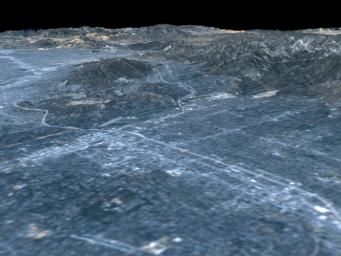This image shows a perspective view of the area around Pasadena, California, just north of Los Angeles. The cluster of hills surrounded by freeways on the left is the Verdugo Hills, which lie between the San Gabriel Valley in the foreground and the San Fernando Valley in the upper left. The San Gabriel Mountains are seen across the top of the image, and parts of the high desert near the city of Palmdale are visible along the horizon on the right. Several urban features can be seen in the image. NASA's Jet Propulsion Laboratory (JPL) is the bright cluster of buildings just right of center; the flat tan area to the right of JPL at the foot of the mountains is a new housing development devoid of vegetation. Two freeways (the 210 and the 134) cross near the southeastern end of the Verdugo Hills near a white circular feature, the Rose Bowl. The commercial and residential areas of the city of Pasadena are the bright areas clustered around the freeway. These data will be used for a variety of applications including urban planning and natural hazard risk analysis.
This type of display adds the important dimension of elevation to the study of land use and environmental processes as observed in satellite images. The perspective view was created by draping a Landsat satellite image over an SRTM elevation model. Topography is exaggerated 1.5 times vertically. The Landsat image was provided by the United States Geological Survey's Earth Resources Observations Systems (EROS) Data Center, Sioux Falls, South Dakota.
Elevation data used in this image was acquired by the Shuttle Radar Topography Mission (SRTM) aboard the Space Shuttle Endeavour, launched on February 11, 2000. SRTM used the same radar instrument that comprised the Spaceborne Imaging Radar-C/X-Band Synthetic Aperture Radar (SIR-C/X-SAR) that flew twice on the Space Shuttle Endeavour in 1994. SRTM was designed to collect three-dimensional measurements of the Earth's surface. To collect the 3-D data, engineers added a 60-meter-long (200-foot) mast, installed additional C-band and X-band antennas, and improved tracking and navigation devices. The mission is a cooperative project between the National Aeronautics and Space Administration (NASA), the National Imagery and Mapping Agency (NIMA) of the U.S. Department of Defense (DoD), and the German and Italian space agencies. It is managed by NASA's Jet Propulsion Laboratory, Pasadena, CA, for NASA's Earth Science Enterprise,Washington, DC.
Size: Varies in a perspective view
Location: 34.18 deg. North lat., 118.16 deg. West lon.
Orientation: Looking Northwest
Original Data Resolution: SRTM and Landsat: 30 meters (99 feet)
Date Acquired: February 16, 2000

 Planetary Data System
Planetary Data System












